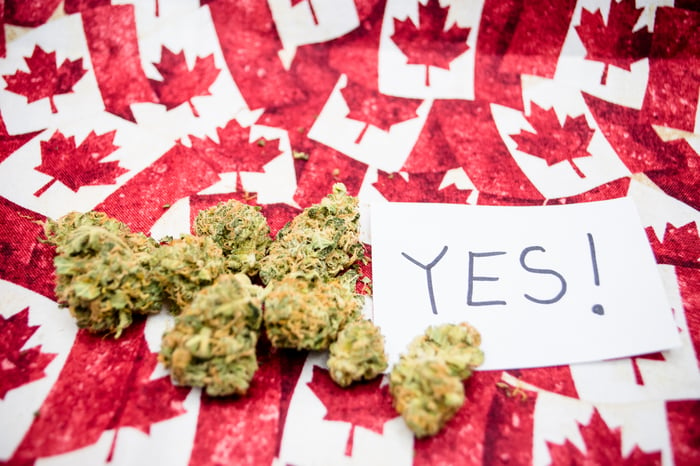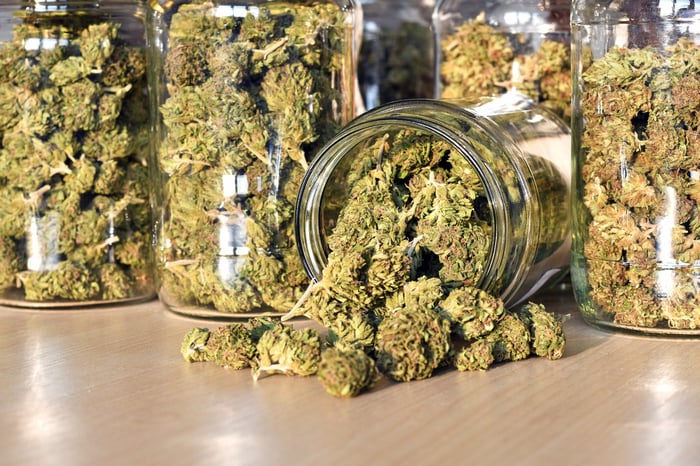In just five days, marijuana history could be made. On Thursday, June 7, Canada's Senate is set to vote on bill C-45, which is more commonly referred to as the Cannabis Act. If passed, it would become the first developed country in the world to legalize adult-use marijuana, with sales expected to commence in August or September.
At this point, passage looks to be all but certain. Conservatives in the Senate who'd opposed the Cannabis Act are clearly in the minority, and a two-year tax-sharing agreement lined up with most provinces bears hope that Canada has all of its ducks in a row. It's this expectation of passage that's sent pot stocks ascending to the heavens in recent years.
But whether you're a cannabis proponent, investor, or casual sideline observer, there's probably quite a bit you don't know about Canada's marijuana industry. Here are a few of the more important points to help educate yourself.

Image source: Getty Images.
1. Exports are going to be the key to its success
Legalizing adult-use cannabis in Canada is expected to generate in the neighborhood of $5 billion for the industry. But, truth be told, not all of the cannabis being grown in the country will be sold to domestic consumers. In reality, Canadian growers have been ramping up their operations with the hope of securing long-term supply deals with the more than two dozen countries around the world that have legalized medical marijuana.
With the exception of the Netherlands, no other country aside from Canada is actively exporting marijuana. Australia and Israel have plans to become exporters, but they'll be producing peanuts compared to what Canadian growers plan to export to foreign markets.
2. Cannabis taxes are so low, legal weed could steal beer and liquor industry market share
One of the keys to successfully launching recreational weed in Canada, according to Prime Minister Justin Trudeau, is eliminating the black market from the equation. In order to do so, legal pot prices have to be comparable to the black market. The proposed tax on Canadian weed, which was outlined in October, is $0.77 per gram (CA$1) on cannabis sales costing up to $7.70 (CA$10), and a flat 10% tax on more expensive cannabis strains. By comparison, some folks in California who are purchasing recreational marijuana could be paying up to a 45% tax rate.
How good of a deal is this for Canadians? According to Aaron Wudrick, the Canadian Taxpayers Federation federal director, Canadians are liable for a tax of about 80% on spirits, 65% to 70% on wine, and roughly 50% on beer. This clear gap in taxation may cause some consumers to switch away from various forms of alcohol in favor of cannabis. This makes spirits giant Constellation Brands' investment in Canopy Growth Corp. (CGC 20.65%) last year seem all the wiser.

Image source: Getty Images.
3. Legalization may look different in each province
You should also be aware that each of Canada's provinces may choose to enforce the legalization of adult-use pot differently. For example, each of Canada's provinces have set the legal age of consumption limit at 19 or above, except for Alberta, which will allow adults ages 18 and up to legally purchase marijuana.
Another difference? Some provinces will offer privately run retail stores, whereas some will not. For instance, Quebec and Ontario will only allow consumers to purchase from government-operated storefronts and via online sales. Meanwhile, Saskatchewan won't have any government-operated storefronts, with private retail stores and online sales offering the only means to legally purchase pot.
4. Bought-deal offerings have provided public companies with a financial lifeline
In order to expand production as quickly as they have, publicly traded Canadian pot stocks have had to raise a lot of capital, and have had only one true means to do so: bought-deal offerings. A bought-deal offering is nothing more than the sale of common stock, convertible debentures, stock options, and/or warrants to an investor or group of investors in order to raise capital. Since marijuana is (at least for the time being) still illegal, banks have generally wanted nothing to do with pot businesses.
The upside is that these offerings have provided pot stocks with more than enough capital to grow their operations. The aforementioned Canopy Growth has tripled its licensed growing capacity to 2.4 million square feet just since the year began, and it's aiming for 5.7 million square feet of licensed capacity at its peak.
Of course, be aware that this easy access to financing comes at a price: an increase in the number of shares outstanding. This could adversely impact EPS for years to come.

Image source: Getty Images.
5. The industry is undersupplied (for now), but won't be for long
Lastly, keep in mind that while the supply and demand outlook is mostly guesswork at this point, the industry is initially expected to be undersupplied with cannabis. This is due to the fact that marijuana growers are still in the process of ramping up their operations, as well as receiving cultivation license approvals from Health Canada. Some of the largest players in the industry may not even be at full production capacity until 2020.
However, it's not out of the question that a cannabis oversupply develops in the years to come. With domestic annual demand expected to range between 800,000 kilograms and 1 million kilograms, according to various government reports, and the industry capable of perhaps 2.4 million kilograms of production (if not more) by 2020, figuring out where the extra 1 million kilograms or more will go each year isn't easy. Exports may be able to gobble up all of this excess, which is why they're expected to play such a crucial role for the industry. But if exports can't absorb all of the cannabis produced by growers, expect a sharp decline in cannabis' per-gram price to follow.




